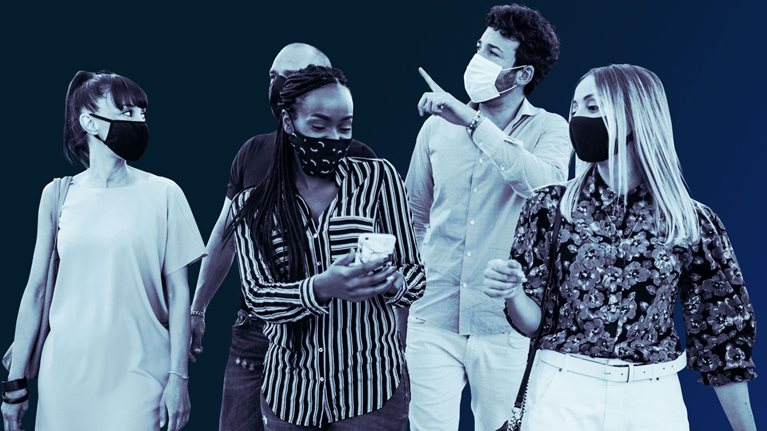A world that has been fervently hoping for a clean break with the COVID-19 pandemic may be disappointed. In many places, the pandemic continues unabated; some countries are currently suffering their highest rates of hospitalization and death. And even in areas where it has subsided, the end point continues to recede into the future. As we wrote in our most recent update to “When will the COVID-19 pandemic end?,” few locations are likely to achieve herd immunity against SARS-CoV-2. The highly transmissible nature of the Delta variant, ongoing vaccine hesitancy, and incomplete protection against transmission by current public-health measures mean that a goal of “zero COVID-19” is very likely unachievable without stringent public-health measures. Most societies, including the United Kingdom, the United States, and much of Europe, will need to learn to live with COVID-19, at least over the medium term.
What’s happening now is not unusual. Epidemics end in one of two ways—either we close off all chains of transmission and drive cases to zero, as with all Ebola epidemics to date, or the disease becomes an ongoing part of the infectious-disease landscape, or endemic, as tuberculosis is today.1 Occasionally, as with smallpox, a previously endemic disease is eradicated.2 But, for the most part, endemic diseases are here to stay. The shift from pandemic to endemic entails a number of practical considerations, as we discuss in this article. But the shift is also psychological, as we will be deprived of the satisfaction that a clean pandemic end point would bring. Instead, societies will have to adapt to living alongside COVID-19 by making some deliberate choices about how to coexist.
Endemic disease does not mean unmanaged disease. Rather, what’s needed is a shift from viewing COVID-19 as a one-time threat that defines society to seeing it as a part of everyday life that we must learn to endure. Around 38,000 Americans die every year in road-traffic accidents—far fewer than from COVID-19 over the past year but still a significant number.3 As a society, we have developed tools to make road travel safer—seatbelts, airbags, impaired-driving laws, and so on. Each road death is a tragedy, and carmakers, public-safety agencies, and many others continually strive to reduce fatalities. But most of us don’t spend much time thinking about road safety; we get in the car, buckle up, and go. Soon, the daily risks we run with COVID-19 may seem as much a part of normal daily life as the risks we run when we put the car in drive or navigate flu season each winter.
A complete approach to managing endemic COVID-19 requires the consideration of four interwoven elements. First, society will have to reach a consensus on what is an acceptable disease burden and use those targets to define an acceptable new normal. We will then need a comprehensive approach to track progress against this standard, define new disease-management protocols to limit deaths, and establish practices to slow transmission. Woven together, these four imperatives form a comprehensive approach to the management of endemic COVID-19 (exhibit). The work is vast and will require action across all segments of society, including government, healthcare providers, employers, the life-sciences sector, and the general public.

Define the new normal
Societies need to set goals for what the new normal will look like and build consensus around them. Goals will vary across locations, but three guiding principles should apply. First, goals must recognize the “whole of society” impact of COVID-19. Targets for the health burden of the disease remain paramount, but countries can also introduce targets for economic and social disruption. Targets for the burden of death or severe disease (such as hospitalizations) and the related impact on healthcare-system capacity will continue to be as important as they have been during the pandemic. But beyond death or severe disease, COVID-19 has affected daily activities (learning and working, for example, and mental health). As such, measures of workdays lost, business closures, and school-absenteeism rates should also be considered.
Defining a new normal in a world where, for 18 months, societies focused on daily cases and test positivity is a material pivot that will need to be carefully communicated. The right metrics are likely to vary by geography: places where COVID-19 exposed the fragility of the health system may choose to focus primarily on not overwhelming their hospitals, while others may embrace a more integrated mix of economic, social, and health factors. Local demographics, citizen sentiment, economic resilience, vaccination status, and other factors should inform these goals. Viewing the target for the total burden of COVID-19 relative to other diseases will be important context.
Second, goals must be realistic and balance the different needs of society. In many countries, zero cases will not be the appropriate target, since it requires ongoing public-health measures that place significant restrictions on society, particularly on businesses and schools. Some countries are, therefore, resetting their expectations: “For this outbreak, it’s clear that long periods of heavy restrictions [have not gotten] us to zero cases,” said New Zealand prime minister Jacinda Ardern. “But that is OK. Elimination was important because we didn’t have vaccines. Now we do. So we can begin to change the way we do things.”4 Goals must also be realistic, or many sectors of society will quickly lose interest. And leaders must not set goals in a way that requires the most vulnerable in society to bear a disproportionate burden—for example, by requiring low-wage frontline workers to communicate or enforce policies.
Third, leaders must build the widest possible consensus around the goals through effective communication, emphasizing the whole-of-society nature of the targets. Much of the political discord created by COVID-19 over the past 18 months has arisen from differences of opinion about the relative importance of health, economic goals, and social goals. Not everyone will agree with every target, but part of managing endemic COVID-19 requires forging a social contract that recognizes the need to control the health impact of the disease while normalizing society to the greatest extent possible. While governments will lead in setting targets, all sectors of society will play a role in providing input and helping to build support for a shared definition of the new normal. Targets will evolve over time as we continue to learn more about what works and what doesn’t, but clarity and consistency of communication will be critical.
Track progress
Once realistic, multisector goals have been established, jurisdictions should track progress against them in easy-to-follow, transparent ways. This can include disease-surveillance metrics, such as hospitalizations and deaths, as well as measures of the wider societal impact of the milder cases of COVID-19, such as lost school days and missed workdays. Public-health measures, such as masking, physical distancing, and testing requirements, should also be deployed based on predefined thresholds of these metrics. In today’s interrelated economies, metrics will have to be monitored globally to understand transmission dynamics and the emergence of new variants and to inform policy around travel restrictions.
As part of disease surveillance, ongoing genomic sequencing will be critical to monitor for the emergence of new variants that would necessitate changes in the approach to managing endemic disease. Many countries have made rapid progress this year in expanding their capacity to sequence SARS-CoV-2. Governments should take the next step and routinize that capability and integrate it with sequencing efforts for other pathogens.
As we better understand the virus and its transmission, monitoring systems should also include a real measurement of which interventions work and which do not. Over time, this information should let us better apply public-health measures in a way that is grounded in real evidence of how they work, with the aspiration of applying the minimum effective package for a given geographic area’s disease status.
With this data and a dedicated focus, our ability to conduct meaningful predictive analysis will continue to improve. New efforts such as the WHO Hub for Pandemic and Epidemic Intelligence in Berlin, the United Kingdom’s plan for a Global Pandemic Radar, and the US Centers for Disease Control and Prevention’s new Center for Forecasting and Outbreak Analytics should help build on the progress in epidemic prediction made over the past 12 months. As our understanding of factors such as seasonality, heterogeneous mixing, and prior immunity improve, our ability to make meaningful forecasts for particular geographies will increase.
Lastly, communication of the monitoring data to the public must be simple and thorough. An analogy might be the fire-danger rating system in the United States, in which multiple factors are combined into a single rating—low, moderate, high, very high, extreme—that is communicated to the public, and which ties directly to policies used to mitigate the risks of fire.5
Limit illness and death
To achieve a new normal in which ongoing COVID-19 transmission is an accepted part of everyday life, societies need to effectively minimize immediate illness, the prevalence and persistence of long-term conditions (“long COVID”),6 and COVID-19-related deaths. All are needed to limit the disruption to individuals’ quality of life, societal well-being, and economic productivity.
The challenge to come will take place on four fronts: the development and administration of vaccines, scaling effective treatments, the preparation of health systems, and the particular needs of vulnerable populations.
Vaccines
The high efficacy of today’s vaccines in preventing severe cases of COVID-19 is critical to normalizing society. Portugal illustrates the point: with 98 percent of those eligible fully vaccinated, severe COVID-19 cases are now rare and almost all public-health restrictions have been lifted.7 In the months ahead, we will encounter old and new complexities in the push for vaccines: convincing vaccine-hesitant adults to get immunized; expanding immunization to younger ages as regulators evaluate filings from vaccine makers; and scaling boosters across the population. Reaching and sustaining high levels of vaccination, particularly as acute disease subsides, will require sustained and novel efforts to engage and educate consumers. Public-sector policies, private-sector practices, and shared cultural values must create incentives for all of the above and make clear that immunization is a shared societal norm that is needed to effectively live with endemic COVID-19.
Moreover, as we transition from a heroic, one-time effort to stand up an infrastructure that put billions of doses in arms to a more routine program of booster vaccination, healthcare providers must integrate and institutionalize COVID-19 vaccinations into their broader ongoing operations.
To stay ahead of the virus, the vaccines themselves must continue to evolve.8 Vaccine strategy, from development and manufacturing to selection, procurement, and distribution, must adapt to emerging science on the prevailing mix of variants of concern, appropriate intervals for boosters, and risk–benefit considerations for subpopulations (for example, the elderly or immunocompromised).
Treatments
When people do get infected, effective treatments become critical. While monoclonal antibodies have proven very effective in a specific population, many COVID-19 patients are still being treated with a 50-year-old steroid (dexamethasone), fluids, and proning.9 New data hold promise for the next generation of oral antivirals that could be widely scaled to help prevent disease progression to hospitalization and death, with several new treatments garnering excitement in late-stage development.10 Improving the armamentarium of treatments would go a long way to limit COVID-19 deaths and remains a huge priority.
As they arrive, new and proven therapeutics and care practices must be incorporated into the standard of care, especially in communities at higher risk of COVID-19 infection and death and those with historical challenges in accessing high-quality care. New treatments are also needed for long COVID. To help navigate this as a society, healthcare providers will need to better characterize the range of symptoms associated with long COVID and develop tailored therapeutics and new innovations that improve recovery and limit disability after infection.11
Health systems
Overwhelmed health systems and healthcare professionals faced with impossible decisions marked some of the darkest moments of the past 18 months. These moments have also been characterized by huge second-order health impacts, as excess deaths from other causes rapidly escalated.12 To help manage future outbreaks, care-delivery systems must develop surge plans that can be quickly triggered to increase care capacity rapidly in response to local or widespread outbreaks and expected seasonal fluctuations, while still ensuring that non-COVID-19 care needs are met.13 Effective management of endemic COVID-19 must also include catching up on preventive and elective care that was missed or delayed by the pandemic.14
Vulnerable populations
The final critical element of limiting death from COVID-19 is outreach to those who are most at risk.15 Some groups, whether because they live in crowded settings, suffer from socioeconomic disadvantage, or have limited access to healthcare, have been disproportionately affected by the pandemic to date. As the level of public attention focused on COVID-19 wanes, societies must be careful to avoid strategies that place a disproportionate burden on the most vulnerable. While some progress has been made, those with low-wage frontline jobs, those living in more crowded settings, and those with the least favorable access to healthcare have too often borne the greatest burden during the pandemic.
Equity should be woven into all of the interventions to limit illness and death. Any approach to living with endemic COVID-19 must have tailored strategies for outreach to these communities, and programs to ensure access to the vaccines, treatments, and care that can best keep them safe.
Slow transmission
In a state of endemicity, slower transmission reduces the direct health burden of COVID-19, minimizes the likelihood that new variants arise, and mitigates the likelihood that epidemic outbreaks lead to societal disruption. In this new normal, we can expect four approaches to become a regular part of daily life: ubiquitous testing; safer interactions in workplaces, schools, and recreation and entertainment locales; and rapid response to transmission hotspots.
Widely available and rapid testing can help individuals and societies take the steps needed to limit further transmission. Current and future innovations in testing must be effectively deployed for specific uses such as screening, diagnosis confirmation, and surveillance. Ubiquitous, frictionless access to testing for all members of society, especially those at higher risk, has proven effective at blunting transmission. What, exactly, this should look like is up for debate but should be available through a wide range of channels—whether widely available, rapid-turnaround tests for asymptomatic patients such as those the United Kingdom has deployed,16 regular employee testing like many employers have instituted, or simply the mass availability of rapid tests and institutionalized behavior of testing every runny nose. Who bears the cost of sustaining this infrastructure will likely be one of the next-order questions to arise.
Because transmission can occur wherever people congregate, most spaces—including workplaces, schools, events, and public areas—must consider how to enable safe interactions. The ways people work, learn, and socialize will return to normal or near normal, but must happen in safe ways that lessen the transmission of risk while being (and being accepted as) minimally disruptive (like wearing seat belts for road safety). The public and private sectors both have important roles to play: a range of policies and practices (like wearing masks in certain contexts or giving up handshakes17) and disincentives and incentives (such as the ability to join public gatherings) will likely hasten the arrival of a new set of social and cultural norms. Over time, infrastructure improvements can continue to reduce the risk of transmission in indoor spaces. For example, reconfiguring workspaces to enable physical distancing, scaling the use of HEPA filters, and improving air flow can all reduce risk of transmission.18
Lastly, when local outbreaks occur despite widespread safer interactions (and they will), societies must have rapid-response infrastructure in place to limit exponential transmission. While case-investigation and contact-tracing capacity have been overwhelmed at some points during the pandemic, they can play critical roles in responding to more localized outbreaks.19 Rapidly deployable mobile testing units, staffed by officials with good local knowledge, can be just as important. Collaboration across the public sector, private sector, and care-delivery system—including the use of common communication platforms and data sharing where possible—will be critical for responding quickly and containing hotspots. While many jurisdictions deployed these approaches too late on the upslope of COVID-19 to have the desired impact, they have a critical role to play on the downslope.
Collectively, the four strands for managing endemic COVID-19 will require a momentous societal shift. Every stakeholder will have an important role to play:
- Governments can build consensus on goals, communicate superbly, and set the right incentives.
- Employers likely have an elevated role, setting policies for their workplace and helping their employees think through the changes.
- Health systems can strike the right balance among competing demands and plan for the inevitable outbreaks and surges.
- Individuals can challenge the convictions they’ve developed in the past 18 months and adopt new behaviors.
The costs will be meaningful, as these imperatives require sustained investment, but the return from enabling normal economic activity will be astronomical. It is critical that leaders align incentives such that sufficient investment is made across sectors to manage endemic COVID-19. Perhaps the hardest of all is the mindset shift, as we slowly accept that COVID-19 is not a temporary phenomenon that we can bury in our memories but rather a structural shift in how we live, requiring permanent changes in behavior. But if we are to truly reclaim our lives, now is the moment to start building.







